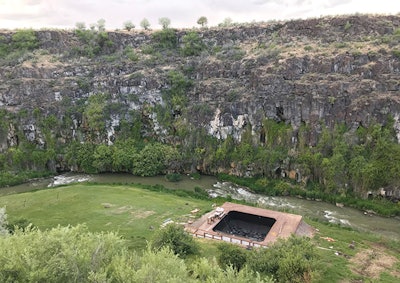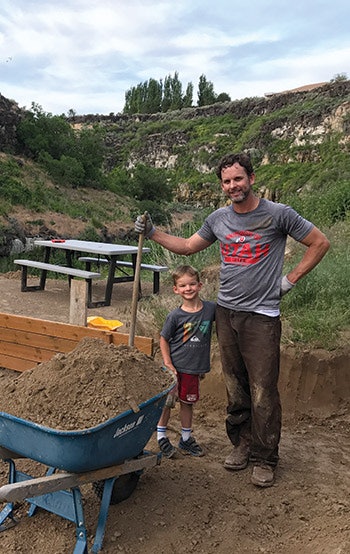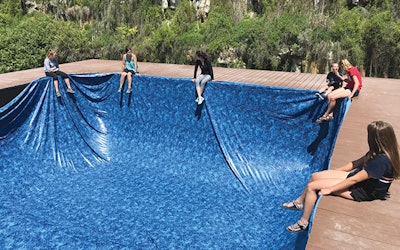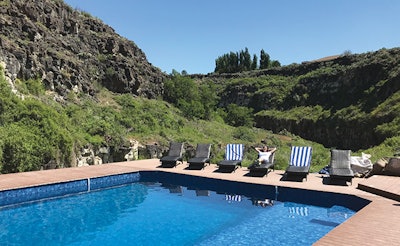
Joshua Hall is not one to shy away from a challenge, so when I called to schedule an interview about a pool he'd dug by hand, he agreed, despite the reconstructive surgery he had scheduled the day before we were to talk. "It's part of the story that adds intrigue," he said in a way that promised it would be worth my while to wait.
The afternoon of the interview came, and figuring he'd still be in rough shape I offered him an out, which he gladly took. "I'm half out of it," he admitted in an email.
Days later, I got a fully functioning Hall on the phone and he told me all about a harrowing accident near the end of the ambitious project that destroyed his shoulder, probably should have taken his life and in the end made him question whether the whole thing had been worth the effort. The story he told is one not only of defying death, but also of making a new friend, battling bureaucracy and learning lessons about patience and perseverance. More than anything, though, it's the story of a guy who really wanted to dig a pool deep in a dangerous canyon gorge and wouldn't give up despite people laughing at him and calling him crazy.
But before I got to questions about the pool, I had to address the elephant in the room.
AQUA: So you're out of the hospital and back home now. What happened?
Joshua Hall: The accident happened back in January, on the second, after the pool itself was finished. I had hired contractors to do the deck around the pool, and they had no idea how hard it would be to get their guys 400 feet down into the canyon to complete the project. They went through like 10 guys who quit. Going down and then getting back out just to get lunch nearly killed guys. They had guys leaving right and left. It was a nightmare. Quite honestly nobody else would have even taken on the project. They're the only people who were crazy enough to do it.
So they were down there in the middle of winter trying to get the thing done, and they would drop off raw material and the guys had to haul it down, because you couldn't get any equipment down there. Well, I'm trying to do them a favor and stay healthy in the process, so my son and I would haul stuff down there for them. It's the day after New Year's and we put a bunch of boards on the rails of our four wheeler and I take it down to the staging area, which is sort of halfway down the canyon. After that, you have to unload and then schlep it down yourself. Well, it's snowy and icy and my son is telling me, "Dad, I don't know if we should be doing this."
RELATED: Courage and Experimentation
We get down there. It's cold so I leave it running and put the handbrake on, but I stupidly don't put it in neutral. As we got off and start pulling the lumber off the rails, one of boards slips off and disengages the parking brake and hits the throttle. So the four wheeler slams forward and takes me with it right off the side of the canyon. I went flying down and got caught up by some willow branches, but I fell about 30 feet. I'm sitting there and the four wheeler is exploding right next to me on the rocks. I can still see it to this day. That thing almost went all the way into the river and the guys working below had to stop it before it did.

So, I can move my arm and legs and my head doesn't hurt. My boy is up there, and he got knocked over, so I was worried about him and the adrenaline was pumping and I climb out of that canyon and examine my son. He's kind of scraped up but he's OK. I go to work that afternoon. That night when I got home and caught my breath I'm like, "I can't move my shoulder." So I put myself in the MRI and it was just torn to pieces. Two surgeries later and still don't have 100 percent function in my shoulder.
That's not really about the pool, though. I'm getting ahead of the story.
All photos courtesy of Joshua Hall
AQ: That's incredible. So, how did you get the idea to do the pool in the first place?
JH: We live in Twin Falls, Idaho. It's a pretty rural area near the Snake River Canyon. Ten years ago my wife and I and our two kids came up and found a piece of property here on one of the adjacent canyon gorges. This particular piece, instead of just being a vertical drop-off, has sort of a terraced topography that gets you down to this small river called Rock Creek. That's the river that the pool is by.
So there was a lot of wild ground down there, and I immediately started to clear it and burn it and I seed it to make it accessible so the kids could go down there and enjoy the river and canyon. For the most part that worked just fine, but when it gets hot, all of that grass that I planted dries up and turns to weeds and it can be a pretty dry place, being in the high desert. There's not a lot of water. So one year I hiked down into the canyon and when I was doing one of these burns and realized there was a spring coming out of the canyon side at a gallon or two per minute. I thought to myself, "If I diverted that spring water over into a retention pond and put in a pump, I could provide water to this cleared area of ground that I created."
RELATED: A Masterful Man Cave
Well, like I said, you can't get anything mechanized down there. So I knew that whatever hole I dug for this retention pond was going to have to be done by hand. So I just brought a shovel down one afternoon and thought, "l'll just see how much rock is in this earth, and if it's rocky and whatever then it can't be done and I'll just stop." Well, in a half hour I was four to five feet down and hadn't hit a single rock. So I kept going.
As I dug further down over the next number of days I realized the ground has about a 15 degree slope down to the river. So I started to back fill on the river side, and then I realized I needed to have retaining walls to make it level. I had some people think it through with me and we constructed some metal A frames. Imagine a vertical piece of steel with a bottom plate. Then you have a connecting plate that forms an A. Then you have a hole at the bottom that I can drive posts down into. These were 150 pounds and almost 6 feet high. We carried these things down and placed them at about 10-foot intervals all around the sides and the deep end of the pool. Once we had these in place we secured them with pressure treated wood and started to create side walls.

So I'm thinking, "Well, I've gone through all this process, I'd better just pull the trigger and make this a pool." It went from a retention pond to a pool. So I started to shape the pool with a shallow end and a deep end. I dug it by hand and it took me three years. I'd go down for a couple of hours after work, enjoy being outside, and I'd haul dirt wheelbarrow by wheelbarrow. I went through two wheelbarrows and several shovels in the process. It turned out to be about 25 by 25 feet. So it's a fairly good-sized pool.
AQ: You did all this without any professional help?
JH: Up to that point, yes. But I once I had all the walls kind of put in, I thought, "How am I going to line this thing?" I can't get concrete down there, I can't get plaster down there, there are no prefab liners that'll fit what I have. So the only thing I could figure out to use was a vinyl liner.
The vinyl liner manufacturer I used was Tara, out of Alabama. So I asked them, "How am I going to secure this liner in place?" They said, well there's a metal track that's been designed by a gentleman named Frank Wall, in Louisiana. I found quite a friend in this guy. He's retired and he just really took a liking to my project and was so helpful.
RELATED: The Desert Deep Purple Project
I was getting really nervous at this point. I'd put so much time into this and had to get it right; I only had one chance. So I would take pictures and email them to Frank and he'd say, "OK, you need this or that," and then he'd even send me the parts I needed! The metal track he invented secures the top of the wall, then the liner bead slips into this track and then locks into place. So I purchased the track, layed a geotextile matting on the ground and then ordered my liner with my dimensions from Tara. Granted, I was just digging with a shovel, so nothing is really perfectly square, so I do have a few wrinkles here and there. But I went through the process of sucking out the air and bringing in the water. I had to drag probably 800 feet of hose from wells up top from two different properties, because when you're filling the pool initially with the liner it can't take days, it has to be done really quickly while you're sucking the air out. I could tell the walls were very relieved to have the water in there, because if you can imagine all that back fill was just pushing on my walls and they were starting to bow, and now there was little counter pressure with the water in it.
AQ: What about the pool equipment?
JH: Before I did any research, I thought the pool would recirculate on its own. But doing the math at one gallon a minute, it came out to about every 10 days that the pool's water would all recirculate. Well, come to find out that's not nearly enough to keep from an algae bloom or other things going on. I didn't anticipate that. So that meant I was going to have to get some sort of pump and filter, and that meant bringing down power. After I already had the deck on it I had to bring in extra fittings. Instead of having skimmers and a bottom drain, I dug a hole through the liner, went under the deck and connected a 1.5-hp deck pump and sand filter. It's on an automatic timer, so at night it just flips on. That thing circulates the whole pool through the filter at night for about six hours, and that's kept it very nice.
AQ: You sent pictures of a helicopter lifting stuff down there. Tell us about that.
JH: Backing up again to before the liner came, I had hired that contracting company to help build a deck around the pool. All of the lumber and everything that went with it we could carry down on straps and things, but the deck called for 215 80-pound bags of Quikrete. I put one on my shoulder and tried to walk down and it just wreaked havoc. Somebody mentioned to me that maybe I could hire a helicopter. I went to the airport and found a company with a bunch of firefighting helicopters and they had one that wasn't being used. I talked to the guy and he talked to the sheriff and they talked to the FAA and got it approved. So the day came and I was on the clock and this huge helicopter came over the top and picked up my 15 or 20 grain bags holding the Quikrete and within an hour they had dropped everything down into that canyon and I was ready to pour the fittings for my deck.
RELATED: A (Lazy) River Runs Through It
AQ: In light of what happened, people must constantly ask you whether it was all worth it.
JH: If I could have my shoulder back there's no way I would do that project again. Believe me, I'm the most grateful guy in the world to have a messed up shoulder because I really shouldn't be alive. But I'm blessed and fortunate and happy. But as far as the work of doing that kind of thing, would I do that again? I don't know. For one thing, I had a neighbor call the authorities because they thought I was damming the river, so I ] had to get extra permits and that was a nightmare.
I mean it was a challenge. No doubt about it. But, on the other hand, we've loved the pool. We've absolutely loved it.
A lot of people think I'm crazy and they laugh and say that that's something only I would do, but I'd rather work outside and get a workout instead of running down the road or biking. The accident is the only reason I regret any of it.

All photos courtesy of Joshua Hall
AQ: Do you think you could have found professionals foolish enough to do the job?
JH: No way. I hired a couple of guys to help me haul stuff; just kind of neighborhood guys. A few people from the hospital who wanted a little extra work. But as far as getting professionals? I mean, I tried to get people to help with the walls and stuff and people just laughed at me.
But I've had other people come to me and ask how I did it, because they'd like to dig a pool, too. It's absolutely doable. With these liners? I mean, it's awesome. You can make it into any shape, get the liner fabricated and you just lock it in with the track. It's a neat product that made this project work.
[Editor's note: I interviewed Hall the day before Thanksgiving 2018, and he was well aware of how much he had to be thankful for. The pool was done, he was still alive (!) and now his kids had a reason to put down the video games and hike down into the canyon. "I come home from work now and ask my wife, 'Where are the kids?' Invariably they're down by the pool," he said.]











































